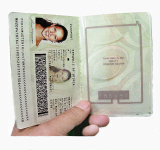Aug. 4, 2003 – Three French companies have joined forces to develop Intelligent Film for Identification (IFI), an RFID-based authentication product for official documents, including passports, visas and identity cards. The product should be available by the end of the year.
The three companies marketing IFI are: Inside Contactless, which specializes in the development of RFID chips; Fasver, a manufacturer of security films for the protection of official documents; and IER, an RFID systems integrator.
The security solution works like this. An antenna made of conductive ink is silk-screened on the passport. An RFID chip from Inside Contactless is attached to the document. The chip couples with the antenna electromagnetically, which means there is no need for wiring bonding or another mechanical attachment procedure.
Additional security measures can be added to the page, such as holograms. Then the page is covered with a thin film that protects the chip and antenna from tampering. A passport using IFI looks the same as any other passport, says Bernard Vian, marketing manager at Inside Contactless.
But the embedded chip can store all of the printed information visible on the document, a unique serial number and biometric data, such as a facial image, fingerprint or iris scan. The International Civil Aviation Organization (ICAO) recently recommended that biometric data be used to improve airline security.
The IFI chips operate at 13.56 MHz, have a read range of 0 to 4 inches (0 to 10 cm) and conform to the ICAO 9303, ISO 144443 and ISO 7816-4 standards, says Inside’s Vian.
When a person presents a passport with the IFI technology to a customs official, the data stored on the chip can be read almost instantly and compared with the information printed on the page. If the passport’s biometric data were a retinal scan, an immigration official could have the holder system could also scan the passport holder’s retina and compare it with the template stored on the chip.
Vian declines to reveal pricing at this time but says “the cost is very competitive.” He adds that the partners have been contacted by a number of government agencies in the United States and Europe that want to test the technology using their own documents. “We should be able to make more specific announcements by the fourth quarter, after important milestones are achieved,” he says.


